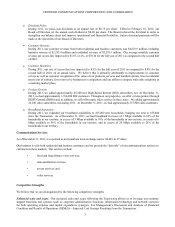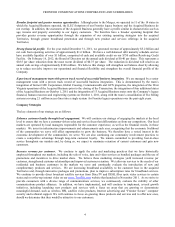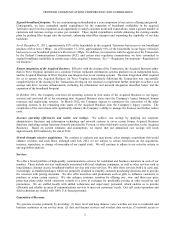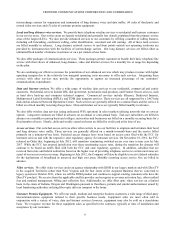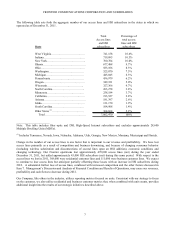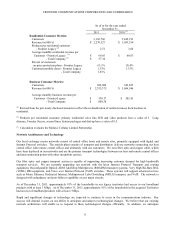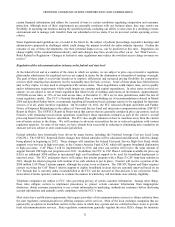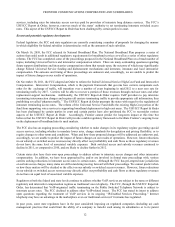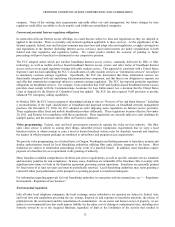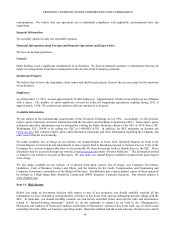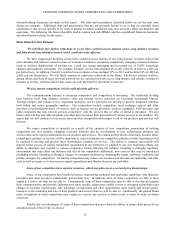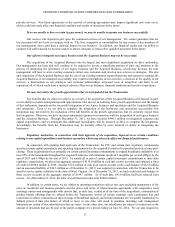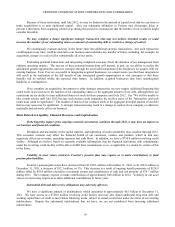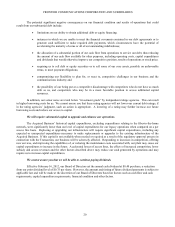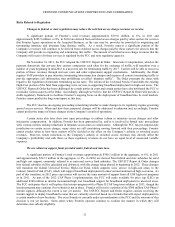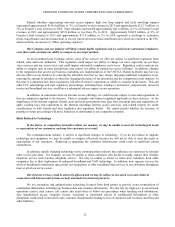Frontier Communications 2011 Annual Report Download - page 16
Download and view the complete annual report
Please find page 16 of the 2011 Frontier Communications annual report below. You can navigate through the pages in the report by either clicking on the pages listed below, or by using the keyword search tool below to find specific information within the annual report.FRONTIER COMMUNICATIONS CORPORATION AND SUBSIDIARIES
13
company. None of the existing state requirements materially affect our cash management, but future changes by state
regulators could affect our ability to freely transfer cash within our consolidated companies.
Current and potential Internet regulatory obligations
In connection with our Internet access offerings, we could become subject to laws and regulations as they are adopted or
applied to the Internet. There is currently only limited regulation applicable to these services. As the significance of the
Internet expands, federal, state and local governments may pass laws and adopt rules and regulations, or apply existing laws
and regulations to the Internet (including Internet access services), and related matters are under consideration in both
federal and state legislative and regulatory bodies. We cannot predict whether the outcome of pending or future
proceedings will prove beneficial or detrimental to our competitive position.
The FCC adopted orders which put wireline broadband Internet access service, commonly delivered by DSL or fiber
technology, as well as mobile wireless based broadband Internet access service and other forms of broadband Internet
access services on an equal regulatory footing with cable modem service. This approach is consistent with a United States
Supreme Court decision upholding the FCC’s classification of cable modem services as “information services” not subject
to mandatory common carriage regulation. Specifically, the FCC has determined that these information services are
functionally integrated with any underlying telecommunications component, and that there is no obligation to separate out
and offer that transmission component subject to common carriage regulation. The FCC has imposed particular regulatory
obligations on broadband services. For example, it has concluded that VoIP and facilities-based broadband Internet access
providers must comply with the Communications Assistance for Law Enforcement Act, a decision that the United States
Court of Appeals for the District of Columbia Circuit has upheld. The FCC has also required VoIP providers to provide
enhanced 911 emergency calling capabilities.
In October 2009, the FCC issued a proposed rulemaking looking at rules to “Preserve a Free and Open Internet,” including
a reconsideration of the legal classification of broadband and proposed restrictions on broadband network management
practices. On December 21, 2010, the FCC adopted an order imposing some regulations on Internet service providers.
These regulations affect fixed and mobile broadband providers differently. These regulations became effective November
20, 2011, and Frontier is in compliance with these regulations. These regulations are currently subject to court challenge by
multiple parties, and the outcome and its effect on Frontier is unknown.
Video programming. Federal, state and local governments extensively regulate the video services industry. Our fiber
optic video service is subject to, among other things, subscriber privacy regulations; requirements that we carry a local
broadcast station or obtain consent to carry a local or distant broadcast station; rules for franchise renewals and transfers;
the manner in which program packages are marketed to subscribers; and program access requirements.
We provide video programming, on a limited basis, in Oregon, Washington and Indiana pursuant to franchises, permits and
similar authorizations issued by local franchising authorities utilizing fiber optic delivery transport to the home. Most
franchises are subject to termination proceedings in the event of a material breach. In addition, most franchises require
payment of a franchise fee as a requirement to the granting of authority.
Many franchises establish comprehensive facilities and service requirements, as well as specific customer service standards
and monetary penalties for non-compliance. In many cases, franchises are terminable if the franchisee fails to comply with
significant provisions set forth in the franchise agreement governing system operations. Franchises are generally granted
for fixed terms of at least ten years and must be periodically renewed. Local franchising authorities may resist granting a
renewal if either past performance or the prospective operating proposal is considered inadequate.
For information regarding approvals by local franchising authorities in connection with the transactions, see “— Regulatory
Environment - Regulation of our business.”
Environmental regulation
Like all other local telephone companies, the local exchange carrier subsidiaries we operated are subject to federal, state
and local laws and regulations governing the use, storage, disposal of, and exposure to hazardous materials, the release of
pollutants into the environment and the remediation of contamination. As an owner and former owner of property, we are
subject to environmental laws that could impose liability for the entire cost of cleanup at contaminated sites, including sites
formerly owned by us or the Acquired Business, regardless of fault or the lawfulness of the activity that resulted in


